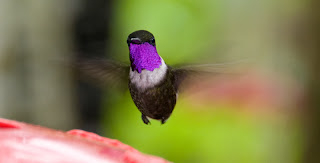By far the biggest attraction at TBL were the hummingbirds. A montage of color and motion engulfed the feeders that adorned the upper deck located off the lodge's Great Room. One could expect to daily see sixteen species. And while the number of species seen daily was astonishing, so too were the number of individuals jockeying for a spot at any of the four feeders. Activity seemed to increase in tempo when it misted or lightly rained. At those times we stopped counting. Over two hundred and fifty might be present without knowing how many more were sitting in the surrounding foliage.
 |
| Green Thorntail |
 |
| Western Emerald |
 |
| Andean Emerald |
 |
| Purple-bibbed Whitetips |
 |
| Purple-throated Woodstar (female) |
 |
| Purple-throated Woodstar (female) |
 |
| Brown Violetear |
 |
| Buff-tailed Coronet |
 |
| White-necked Jacobin |
 |
| Fawn-breasted Brilliant |
 |
| Sparkling Violetear |
 |
| Booted Racket-tails |
Not long after we departed TBL a film crew from Birding Adventures TV arrived to film a couple of programs about the hummingbirds of Tandayapa. The segments recently aired on TV and can also be seen on YouTube. In some of the scenes: Rosa (the kitchen wave); Luke Sietz, the replacement volunteer after we left (Luke is seen standing between Iain and the film host James Currie). José Llanos, our friend and TB guide for our two previous tours of Ecuador joined in the action as well. Many of the scenes around the lodge and Tandayapa Valley were very, very familiar!
How relaxing for us to sit on the deck either by ourselves or sharing the company of guests, with a cuppa coffee, tea, or something stronger, observing all the color and motion the hummingbirds provided. A fair trade, we'd say. We fed them sugar water and they fed our souls!
 |
| Empress Brilliant |
 | ||||
| Empress Brilliant |
 |
| Violet-tailed Sylph |
 |
| Violet-tailed Sylph |
 |
| Velvet Purple Coronet |
 |
| Velvet Purple Coronet |
 |
| Rufous-tailed Humminbird |
 |
| Rufous-tailed Hummingbird |
 | ||||||||||||||
| Green-crowned Woodnymph |
 | |||||
| Green-crowned Woodnymph |
 |
| Brown Inca |
 | ||||||||||||||||||||||||||||||||||||||||||||||||||||||||||||||||
| Purple-chested Hummingbird |
















